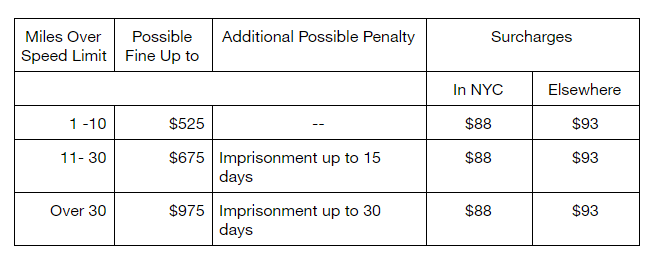Unposted Speed Limits Lead to High Fines and Penalties
Unposted Speed Limits Lead to High Fines and Penalties
With the advent of Mayor DeBlasio’s Vision Zero program, numerous new traffic laws have been enacted throughout New York City. Existing laws have also been changed to increase fines and penalties, create stricter rules, and target specific areas of the city for higher enforcement. The intent of these changes is certainly laudable--reducing driver and pedestrian injuries--but, for the average driver, keeping track of all the rules can be challenging. Public information campaigns, however, only go so far in educating the public.
Drivers are expected to know the rules of the road, no matter how long it has been since they studied for their licenses. Ignorance of the law is rarely a viable defense against a violation of traffic rules. With that in mind, it is imperative to know the difference between posted signage on New York City streets that warn drivers of the speed limits, and also know that sometimes there is a lower speed limit that might not be posted but still obligates compliance.
What is an Unposted Speed Limit?
Almost every state has what is known as an “unposted” speed limit. Whenever a road does not have a sign stating the speed limit, by default one exists. No sign indicating the speed limit is necessary to enforce the speed limit. Drivers can be--and routinely are--stopped for speeding and issued a citation on these roads. States and local municipalities can also modify the unposted limit to a different speed.
Drivers are expected to know their local speed limits wherever they are. The only warning to drivers is an actual sign, usually at the borders of the local jurisdiction, indicating the unposted speed limit. After that, the driver is required to remember the speed within the designated area. In some places the mere existence of an unposted speed limit law is still sufficient to justify a ticket for exceeding such limit. Ignorance of the law is not an excuse.
What Is New York City’s Unposted Speed Limit?
In November 2014, the unposted speed limit in New York City was lowered to 25 miles per hour as part of the Vision Zero program. Many drivers assume--wrongly--that they can use their own discretion for speed on an unposted road. Drivers do have an obligation to use reasonable judgment depending on local conditions, but that decision sometimes means proceeding slower than the posted or unposted speed. For instance, in hazardous weather, a driver should use good judgement to drive more slowly regardless of the maximum speed posted. Typically, under no circumstances can a driver use their own discretion to exceed the speed limit.
With over 200 miles of roadway within New York City, speed limits can vary. When they do, the speed limit is posted, particularly on highways, and bridges and in tunnels. With almost every new initiative under Vision Zero, additional traffic enforcement officers are included as part of the plan. To fund these initiatives, the collection of fines and fees is critical. With more officers on the street and administrative pressure to increase enforcement, the likelihood of receiving a ticket for all kinds of violations has increased dramatically.
Fines and Penalties for Unposted Speed Limit Violations in New York City
Getting a speeding ticket in New York City can be costly. Between upfront fines and fees followed by points on a driver’s license, the impact for speeding can be felt for years after the incident. The burden of high fines, followed by potential increases in insurance premiums due to points accumulating on a license, can be an expensive, time-consuming, and frustrating. A New York City traffic attorney can sometimes alleviate the damage by exploring all avenues to reducing these costs when possible.
The fines and penalties for unposted speed limit violations are no different than those for posted speed limits. From the law’s perspective, speeding is speeding. These penalties are critical to remember in the ease of exceeding a low unposted speed limit like 25 miles per hour.
Speeding fines are assigned by the New York State Vehicle and Traffic Law, Article 30, Section 1180-1:
In addition, the New York Department of Motor Vehicles (DMV) uses a Points System to apply further penalties for traffic violations. Under this system, a driver accumulating 11 points at any time within an 18-month period may receive a license suspension or even revocation.
Accumulating 6 or more points in an 18-month window results in a Driver Assessment Responsibility (DAR) fee . For 6 points, the annual fee is $100 for three years. For every point over 6, the fee increases $25 per point. Depending on the location, an additional court surcharge of either $88 or $93 per violation is applied.
With the fines for slightly exceeding the unposted speed limit are severe as it is, simply going as slow as 36 miles per hour increases the costs significantly.
New York City Lawyers Can Help with Unposted Speed Limit Violations
Violations can also cause your insurance premium to rise. While you may not be able to avoid a fine, a traffic lawyer in the NYC system can be a valuable asset in trying to reduce license points in ways an individual might not understand is impossible. It is in your best interest financially to explore your options whenever possible before you pay the fines.
CALL WAXMAN & BEER
212-269-3988
With our 60 years of combined experience working with the New York Legal System and Most NY Traffic Courts, our team of local traffic lawyers will defend your tickets saving you money and time. We will aggressively contest your violations and seek to reduce your sentence, lower fines, and avoid getting points in order to prevent suspension or revocation of your license as well as increased insurance premiums



